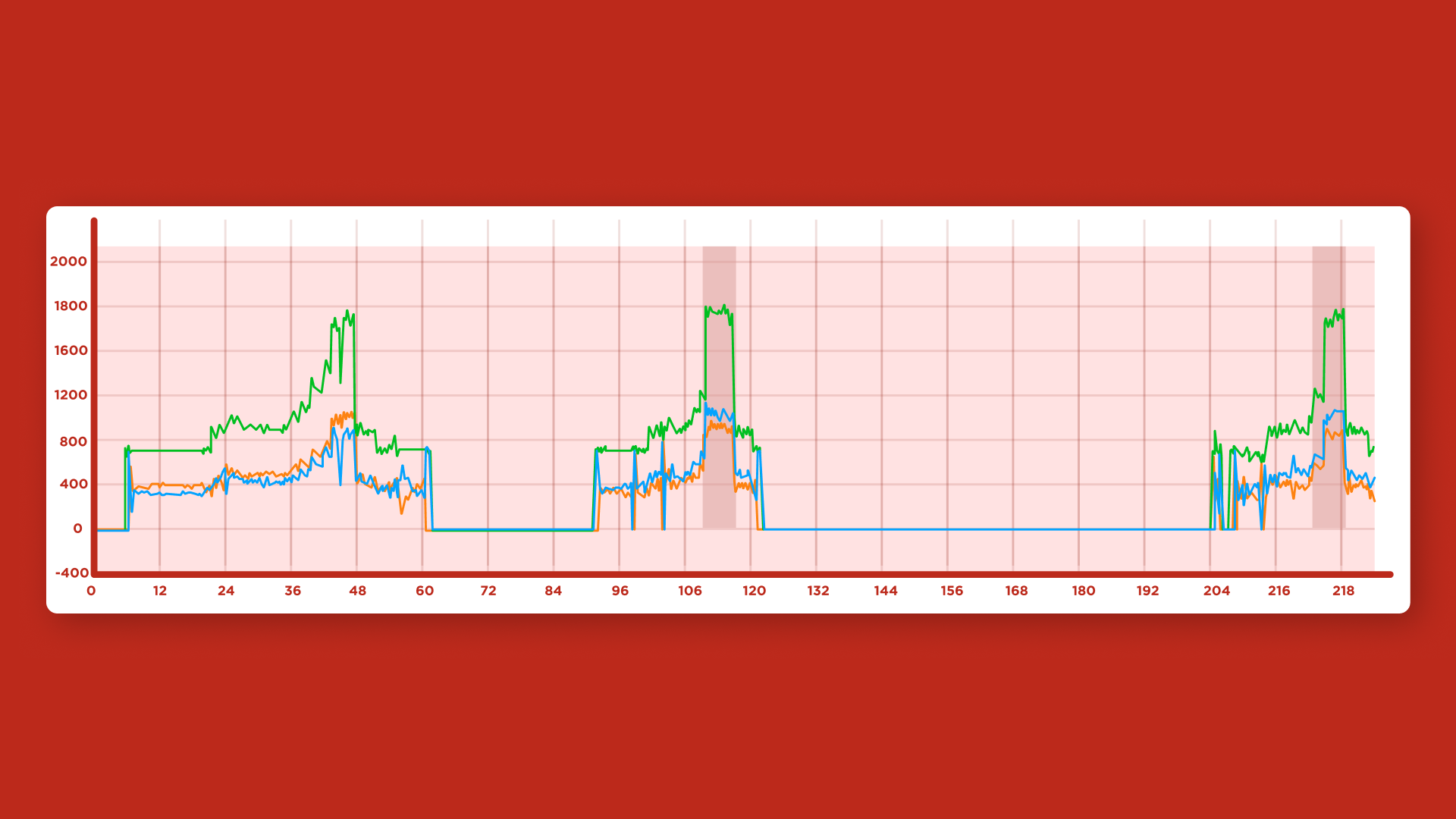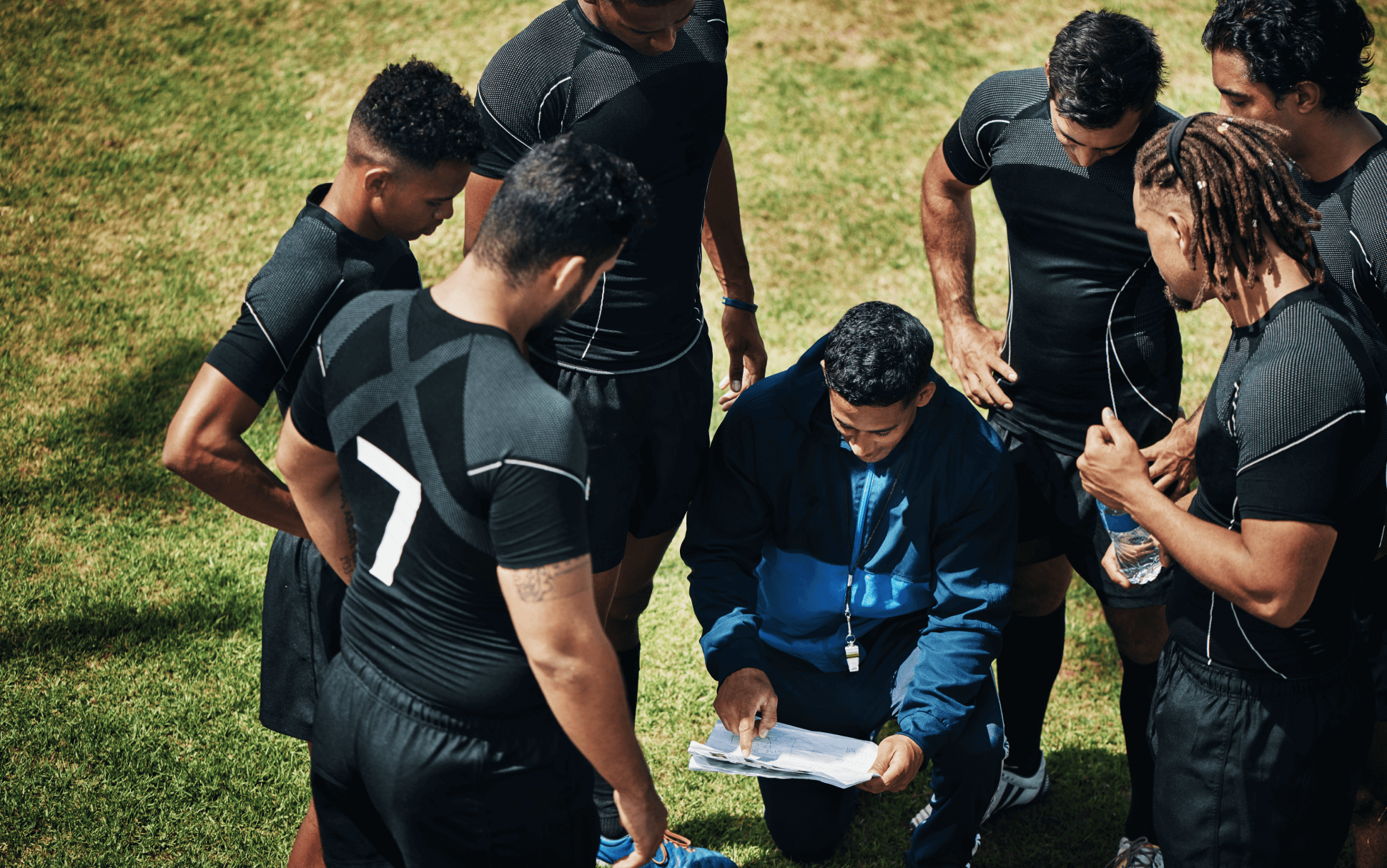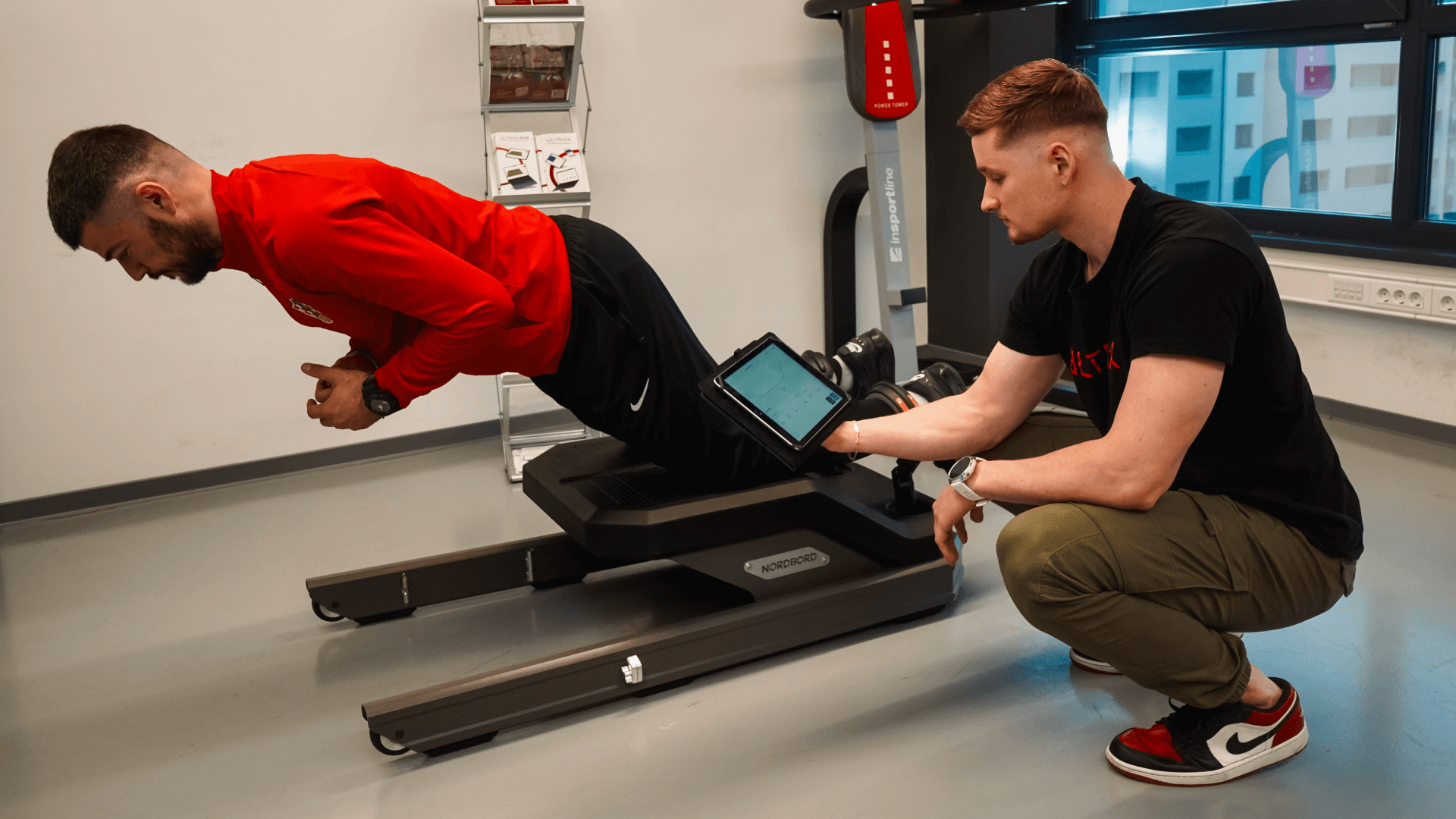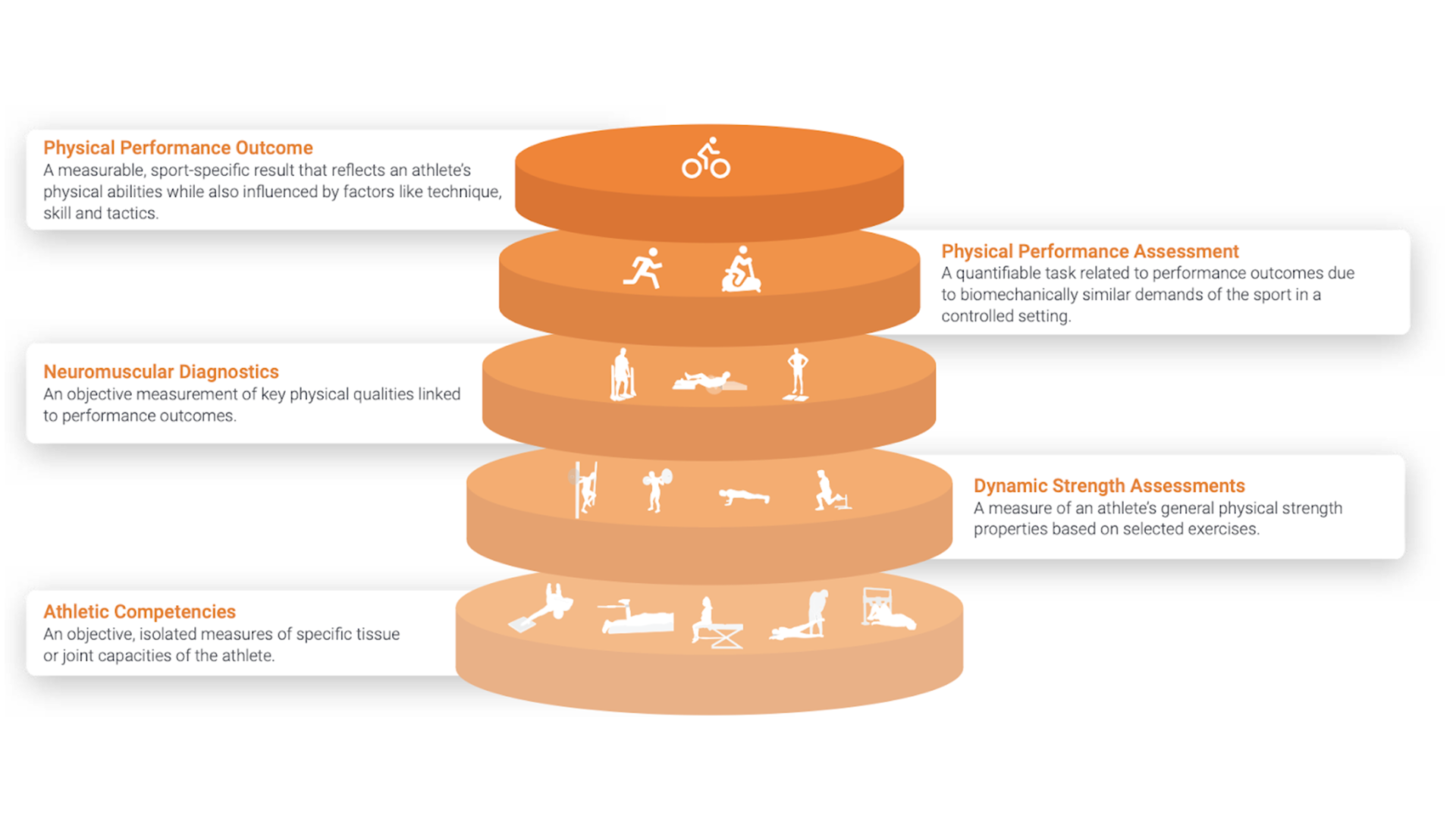What is Rate of Force Development (RFD)?
The Rate of Force Development (RFD) refers to how quickly a muscle or group of muscles can generate force during a contraction. It is measured as the slope of the force-time curve, expressed in Newtons per second (N/s). Unlike maximal force, which represents the highest force a muscle can produce, RFD focuses on how fast that force is developed, making it essential for explosive movements such as sprinting, jumping, weightlifting, and rapid directional changes. Maffiuletti et al. (2016).
In many sports and real-world scenarios, the time available to generate force is very limited, which means that RFD is often a more critical factor than maximal strength alone in determining performance. For instance, sprinters and jumpers rely on a high RFD to produce explosive power in short time frames. Similarly, weightlifters must develop force rapidly to overcome external resistance and complete lifts efficiently. Hernández-Davó & Sabido (2014).
RFD and Its Time Dependency
RFD is analyzed within the 50–200 millisecond window, as this period is critical for determining an individual’s ability to generate force quickly. Kozinc et al. (2022). In most athletic movements, such as sprint acceleration, change of direction, and jump take-offs, the time available to apply force is extremely limited. Because of this, maximal strength alone is not enough—the ability to generate force rapidly (RFD) becomes a key performance factor. Maffiuletti et al. (2016).
Research has demonstrated that different contraction types influence RFD outcomes:
- Ballistic (pulse-like) contractions, which involve applying force rapidly and releasing it immediately, tend to produce higher RFD values.
- Explosive sustained contractions, where force is built up and maintained, may produce a lower RFD but result in greater total force output.
These findings suggest that ballistic contractions should be prioritized when maximizing RFD is the goal, whereas sustained contractions may be more useful when training both peak force and RFD together. Maffiuletti et al. (2016).
Eccentric Rate of Force Development (Eccentric RFD)
While most discussions on RFD focus on concentric force production, eccentric RFD—the speed at which force is generated during eccentric (lengthening) muscle contractions—is just as important, particularly for deceleration, braking, and injury prevention.
Deceleration is a fundamental component of movement that often determines an athlete’s ability to control their body efficiently. Many non-contact injuries, such as ACL tears and hamstring strains, occur during the deceleration phase when forces exceed the muscles’ capacity to absorb them. A higher eccentric RFD allows muscles to dissipate these forces quickly and safely, reducing stress on ligaments and joints.
When an athlete stops or changes direction, eccentric RFD determines how effectively they can absorb and control force in a short time frame. If eccentric force production is too slow, the athlete may compensate by using poor mechanics, increasing the risk of joint instability, excessive loading, and soft-tissue injuries. Conversely, an athlete with well-developed eccentric RFD can stop efficiently, maintain balance, and transition smoothly into their next movement. Nishiumi et al. (2023).
Key Eccentric Variables and Their Role in Performance
Several eccentric force variables play a crucial role in determining an athlete’s ability to absorb and generate force. These variables are key indicators of movement efficiency, injury risk, and explosive performance:
- Eccentric Force: The total force produced during the lengthening phase of movement. Higher eccentric force enhances deceleration efficiency and leads to better control before explosive movements.
- Eccentric Rate of Force Development (Eccentric RFD): The speed at which force is absorbed and generated eccentrically. A higher eccentric RFD improves an athlete’s ability to stop and reaccelerate quickly, reducing injury risks and enhancing agility.
- Braking Force: The peak force applied during the braking phase of a movement. Athletes with greater braking force can control landing forces more efficiently, leading to improved jump performance and sprint acceleration.
- Braking Impulse: The total force applied over time during the braking phase. Higher braking impulse allows for better force absorption and contributes to smoother directional changes.
- Eccentric Power: The rate at which work is performed during eccentric movement. Increased eccentric power improves energy transfer from eccentric to concentric phases, boosting jump height and reactive strength. Nishiumi et al. (2023).
Adaptations to Training that Influence RFD
Neural Adaptations
Motor Unit Recruitment
The ability to generate power is heavily dependent on the nervous system’s ability to recruit motor units effectively. High-threshold motor units, which control fast-twitch muscle fibers, are essential for explosive movements and rapid force application. Training improves motor unit recruitment by lowering the threshold at which they are activated, allowing for faster and stronger contractions. Ballistic and explosive exercises facilitate earlier recruitment of these high-threshold units, leading to an enhanced rate of force development and improved athletic performance. Cormie, McGuigan, & Newton (2011).
Firing Frequency
Motor unit firing frequency, or the rate at which neurons send impulses to muscle fibers, influences both force generation and contraction speed. Higher firing rates lead to greater force output and an increased rate of force development. Resistance and explosive training enhance firing frequency, particularly during maximal contractions, contributing to improved power production. In ballistic contractions, motor units fire at extremely high frequencies initially before gradually declining, ensuring rapid force expression. Cormie, McGuigan, & Newton (2011).
Motor Unit Synchronization
Synchronization of motor units refers to the simultaneous activation of multiple units, contributing to enhanced force summation. Increased synchronization is often observed following strength and power training, particularly in movements requiring high power output. While excessive synchronization may not always be beneficial for endurance-based activities, it plays a significant role in improving explosive force production and athletic performance. Cormie, McGuigan, & Newton (2011).
Inter-Muscular Coordination
Effective movement requires precise coordination between different muscles. The activation of synergists, which assist the primary movers, improves force application and stability during dynamic movements. Training enhances the coordination of these muscles, optimizing power output and movement efficiency. Antagonist co-activation, where muscles opposing the movement contract simultaneously, can limit force production if excessive.
Training reduces unnecessary antagonist activation while maintaining sufficient co-activation for joint stability, allowing for more efficient and powerful movement execution. Cormie, McGuigan, & Newton (2011).
Morphological Adaptations
Muscle Fiber Type
Muscle fiber composition plays a crucial role in power production, with Type II fibers having a significantly greater capacity for force generation and contraction velocity compared to Type I fibers. Type II fibers exhibit higher ATPase activity, enhanced calcium release, and faster cross-bridge cycling, allowing for more rapid and powerful contractions.
Strength and power training lead to shifts in muscle fiber composition, typically from Type IIx to Type IIa, optimizing force output and fatigue resistance. While genetics influence fiber distribution, training can induce structural and functional adaptations that enhance power production. Cormie, McGuigan, & Newton (2011).
Muscle Architecture
The structural organization of muscle fibers determines force generation potential and contraction velocity. Cross-sectional area is a key factor, as larger muscles generate greater force, primarily due to hypertrophy of Type II fibers. Training increases cross-sectional area through the addition of myofibrils, improving overall contractile force. Fascicle length is another critical factor, as longer fascicles allow for higher contraction velocities and improved power output.
Explosive and sprint training can induce increases in fascicle length, which enhances shortening velocity and force application. Pennation angle, the orientation of muscle fibers relative to the tendon, also influences force production. Increases in pennation angle due to resistance training optimize muscle force transmission, while more rapid contraction-based training may maintain a lower angle for improved velocity of movement. Cormie, McGuigan, & Newton (2011).
Tendon Properties
Tendon stiffness plays a key role in transmitting force from muscle to bone. Stiffer tendons enhance power by reducing energy loss during rapid movements, making force transfer more efficient. Strength training increases tendon stiffness, improving neuromuscular efficiency and force application. However, in activities that require elasticity, such as sprinting and jumping, a balance between tendon stiffness and compliance is necessary to optimize energy storage and return. Cormie, McGuigan, & Newton (2011).
Activation of Synergist
Synergist muscles assist the primary movers in force production and stability during movements. Efficient activation of synergists improves movement execution, enhances stability, and allows for greater power output. Training, particularly strength and explosive exercises, enhances the activation and coordination of synergist muscles, ensuring optimal force application. Well-trained athletes exhibit more precise control over synergists, reducing energy loss and maximizing efficiency in high-power movements. Cormie, McGuigan, & Newton (2011).
Co-Activation of Antagonists
Antagonist muscles oppose the movement of the agonist and play a role in joint stabilization. Excessive co-activation can reduce force output and limit power development. However, some level of antagonist activation is necessary for coordinated movement and injury prevention. Strength and power training reduce unnecessary antagonist co-activation, allowing for greater force production while maintaining stability. This adaptation ensures that maximal power can be applied with minimal resistance from opposing muscle groups. Cormie, McGuigan, & Newton (2011).
Testing Rate of Force Development: The Isometric Mid-Thigh Pull (IMTP)
Overview of the Isometric Mid-Thigh Pull (IMTP)
The Isometric Mid-Thigh Pull (IMTP) is a widely used testing protocol to assess an athlete’s Rate of Force Development (RFD), peak force (PF), and neuromuscular characteristics. This test is particularly valuable for strength and conditioning coaches, as it allows for the evaluation of an athlete’s explosive strength capabilities. During the test, as shown in the first image, the athlete explosively pulls the bar for a second, mimicking an on-and-off action (1 second on, 1 second off).
After the test, the data is analyzed to extract specific time windows, such as 0–30 ms, 0–50 ms, 0–75 ms, 50–100 ms, and 150–200 ms, to evaluate the athlete’s RFD profile and final performance assessment.
To ensure valid and reliable results from the IMTP, the following best practices should be followed:
- Standardized Positioning
- The bar height and knee angle should replicate the second pull position in weightlifting (knee angle ~120-130°).
- The athlete should be strapped to the bar to minimize movement.
- Maximal Intent
- Athletes should be instructed to “pull as hard and as fast as possible” to ensure maximal force expression.
- A countdown cue (e.g., “3, 2, 1, pull!”) is recommended for consistency.
- Pre-Test Warm-Up
- A structured warm-up including cycling and dynamic stretching improves reliability.
- Performing submaximal dynamic mid-thigh pulls before the IMTP test can optimize neuromuscular activation.
- Consistent Sampling Methods
- Predefined RFD time bands (0–30 ms, 0–50 ms, 0–75 ms, 50–100 ms, 150–200 ms) should be used for consistent and reliable results.
- Data from these time windows is analyzed to determine the athlete’s explosive strength and RFD efficiency.
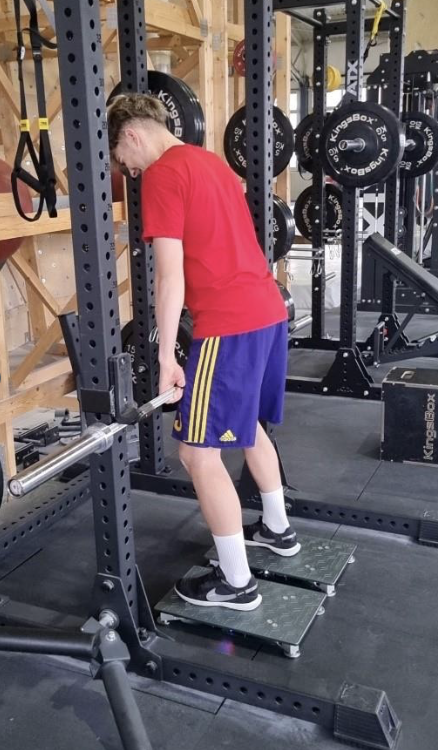
Analysis of Testing Results
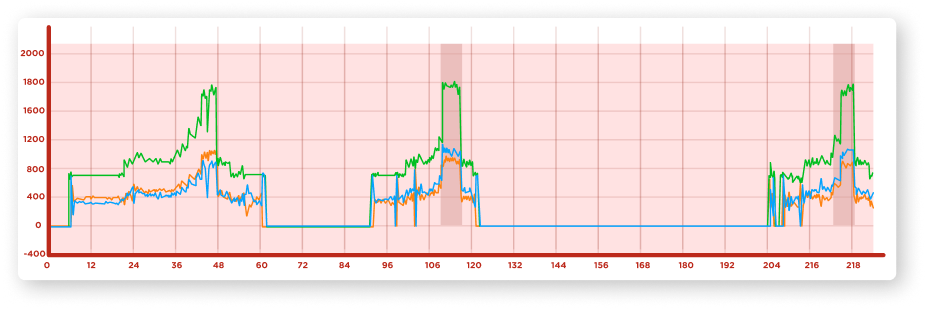
The force trace in the image represents data from a single testing session, captured using VALD software, which provides precise measurements of an athlete’s ability to generate force across different phases of RFD assessment. The test evaluates early-phase RFD (0-100ms) and late-phase RFD (150-200ms), offering valuable insights into neuromuscular efficiency and explosive potential.
For a 15-year-old soccer player we tested using VALD software, improving early-phase RFD is crucial for fast acceleration, agility, and quick reaction times on the field. The test results help determine whether an athlete naturally relies on rapid force application or requires additional targeted training to enhance explosive power in shorter timeframes.
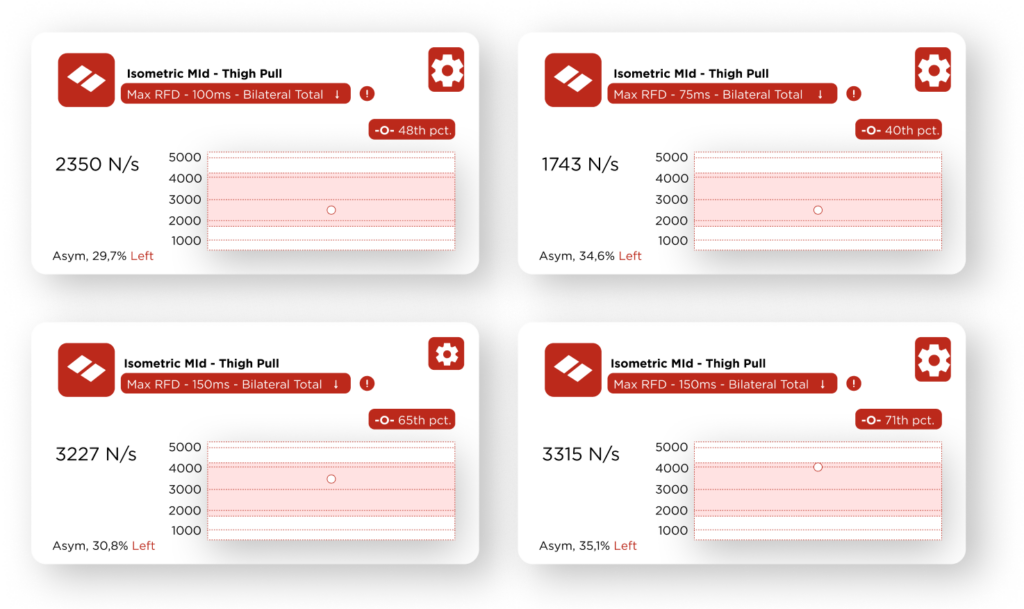
Key findings of testing results for a 15years old soccer player:
- Peak Force (1770 N): This value represents the maximum force output of the player. For a 15-year-old soccer player, this is moderate to above-average compared to athletes of similar age and sport background.
- Early RFD (75ms – 100ms):
- The RFD at 75ms (1743 N/s) is relatively lower compared to later time points.
- The RFD at 100ms (2350 N/s) shows a significant increase, indicating a delayed but improving force production.
- Later RFD (150ms – 200ms):
- RFD at 150ms (3227 N/s) and RFD at 200ms (3315 N/s) indicate strong late-stage force production.
- The peak RFD occurs around 200ms, suggesting the player relies more on longer activation times for generating explosive power.
Conclusion & Recommendations
- The player has good overall force production but relies on longer time frames (150-200ms) to generate force.
- Early phase RFD (0-100ms) is lower, which may indicate a lag in explosive strength during initial acceleration phases, crucial for sprinting and quick directional changes in soccer.
Practical Application of Ballistic and Plyometric Training
Ballistic training is designed, ensuring that force is applied continuously throughout the full range of motion. This leads to superior early-phase RFD, which is critical for movements requiring rapid force production. Key ballistic exercises include trap bar jump, bench press throws, medicine ball throws, half squat with rapid eccentric and concentric phase…
These exercises improve the ability to generate force quickly and efficiently, allowing athletes to maximize power output. While doing these ballsitic exercises, the most important thing is an athletes intent, if the athlete is not giving his max or if he is in the fatiqued state, you can throw away all of the adaptations. One more thing, using velocity based devices is a must, do no’t collect garbage reps and time beats power.
Here we going to include some protocols for practical use using Ultrax Drill:
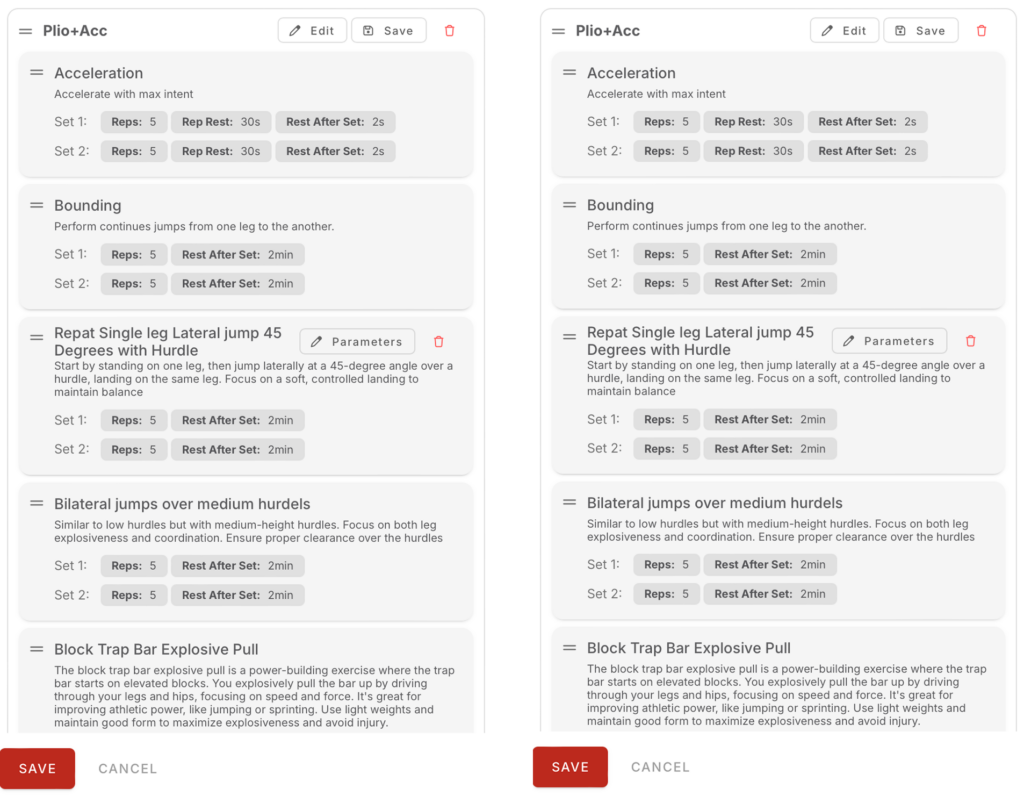
Integration of explosive training in few weekly microcyles:
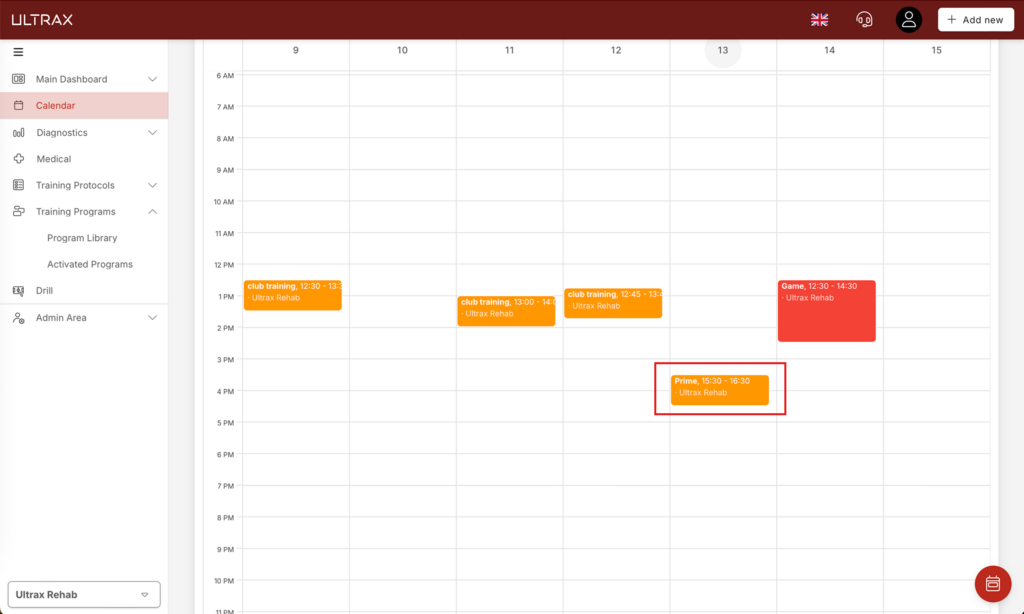
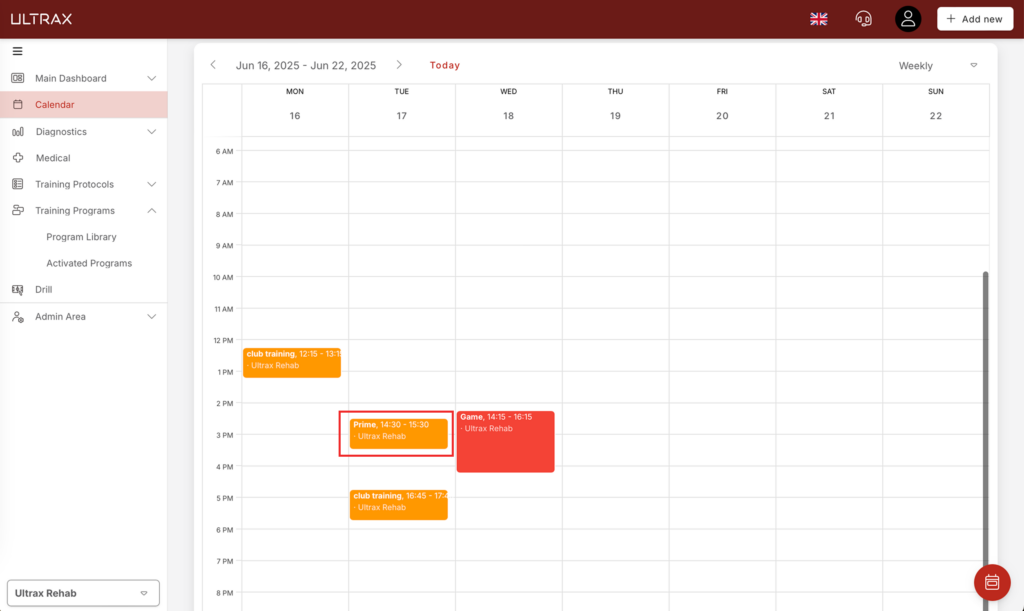
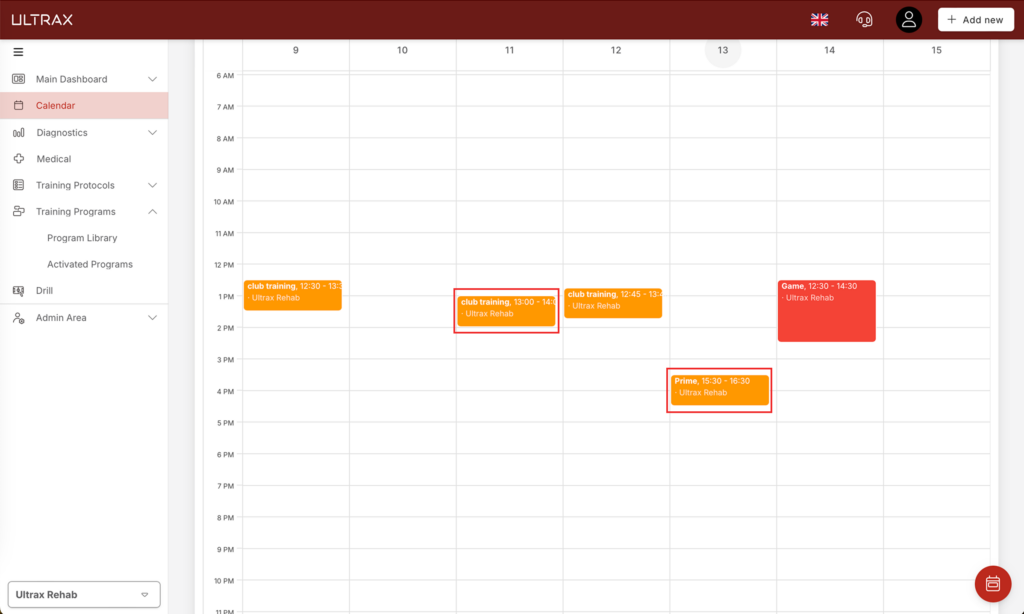
In weekly microcyle one of the effective strategies is combining explosive training with strength work, even twice per week in season. However, careful consideration must be given to the type of muscle contractions (eccentric, concentric, isometric), methods and the overall volume of the training to avoid overload or fatigue, especially on MD-2 and MD-1.
A useful addition to the weekly plan is the “prime” session, typically performed on MD-1 (match day minus one). This is a short, high-intensity low volume explosive session executed before the team’s field work. For some players, this kind of priming stimulus is essential and can even be performed on match day itself, helping them feel sharp and mentally prepared.
Personally, I like to microdose explosive training twice per week: Once on the most intensive training day, and once on MD-1, as a priming stimulus before the match, combining methods such as plyometric, ballistics, contrasts.
Note on Training Protocols
These training protocols are provided as examples . The protocols, exercises, and volume should be adjusted based on the current physical condition, age, experience level, and individual needs of the athlete or a team.
- Exercise selection should align with the athlete’s goals.
- Load, volume, and rest periods should be progressively adjusted according to the athlete’s training experience and recovery capacity.
- Younger or less experienced athletes may require modified intensity and lower complexity drills to develop fundamental movement skills safely.
- More advanced athletes can incorporate higher-intensity ballistic and plyometric exercise to maximize explosive power and neuromuscular efficiency.
References
1. Kozinc Ž, Pleša J, Djurić D, Šarabon N. Comparison of Rate of Force Development between Explosive Sustained Contractions and Ballistic Pulse-like Contractions during Isometric Ankle and Knee Extension Tasks. Appl Sci. 2022;12(10255). doi:10.3390/app122010255.
2. Cormie P, McGuigan MR, Newton RU. Developing Maximal Neuromuscular Power: Part 1 – Biological Basis of Maximal Power Production. Sports Med. 2011;41(1):17-38. doi:10.2165/11537690-000000000-00000.
3. Tsoukos A, Veligekas P, Brown LE, Terzis G, Bogdanis GC. Delayed Effects of a Low-Volume, Power-Type Resistance Exercise Session on Explosive Performance. J Strength Cond Res. 2018;32(3):643–650. doi:10.1519/JSC.0000000000002345.
4. McMaster DT, Gill N, Cronin J, McGuigan M. A Brief Review of Strength and Ballistic Assessment Methodologies in Sport. Sports Med. 2014;44(5):603–623. doi:10.1007/s40279-014-0145-2.
5. Nishiumi D, Nishioka T, Saito H, Kurokawa T, Hirose N. Associations of Eccentric Force Variables during Jumping and Eccentric Lower-Limb Strength with Vertical Jump Performance: A Systematic Review. PLoS One. 2023;18(8):e0289631. doi:10.1371/journal.pone.0289631.
6. Hernández-Davó JL, Sabido R. Rate of Force Development: Reliability, Improvements, and Influence on Performance. Eur J Hum Mov. 2014;33:46–69.
7. Maffiuletti NA, Aagaard P, Blazevich AJ, Folland J, Tillin N, Duchateau J. Rate of Force Development: Physiological and Methodological Considerations. Eur J Appl Physiol. 2016;116(6):1091-1116. doi:10.1007/s00421-016-3346-6.

